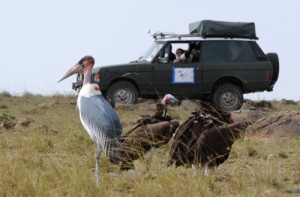Update from The African Raptor Expedition by Simon Thomsett and Laila Baha-el-Din

(Part I) Kenya to Botswana
We left Nairobi on February 15th and after spending a few days in the Masai Mara, we drove into Tanzania where we found large herds of wildebeests calving in the southern part of the Serengeti. With them, we found large numbers of vultures feeding on the calves that didn’t make it. We were driving southward along the Pare Mountains at dusk when we spotted a Taita Falcon hunting swifts. Still further south in Mikumi National Park, we saw our first and last Dickinson’s Kestrels of the trip and in Ruaha National Park, large numbers of Eurasian Hobbies were making the most of the rain and the termites that came with it.
The parks in Tanzania support apparently healthy numbers of raptors, but we were disappointed to find an absence of wildlife outside of parks. We hypothesised that the reasons for this may include legal hunting and legal but abused export of wild birds. Poisoning of wildlife and vultures is an emerging issue.
To avoid the long, monotonous stretch through northern Zambia, we crossed from Tanzania into Malawi. We did not give the country much chance, mostly just driving through it, sticking to main roads. But what we saw was very little. Over the course of three days in Malawi, we spotted a couple of Fish Eagles and a few flocks of migratory falcons (Amur Falcons and Lesser Kestrels).
In Zambia, we went straight to South Luangwa National Park. Owing to heavy rains there, we were not able to explore it as we would have liked but were pleasantly surprised by the number of Banded Snake Eagles we encountered. We spent another couple of days driving through Zambia and arrived to see Victoria Falls and to look for Taita Falcons on the Zambezi Gorge (sadly without success). From there, we crossed the border into Botswana.
(Part II) Botswana and Namibia
Our travels in Botswana were slightly restricted by the amount of rain they had prior to our arrival. The Okavango Delta, for example, was impassable. Our first stop was Chobe National Park which was great for raptors. Of the falcons, we saw Peregrines, Red-necked Falcons, and Lanners, as well as our first and last African Hobby of the trip. Eagles were well represented, with African Hawk-eagles, Martial Eagles, Tawny Eagles and Bateleurs commonly seen. The key issue with regard to raptor conservation in Chobe seemed to be the amount of trees damaged and destroyed by elephants.
We met Pete Hancock in Maun. He informed us of his monitoring work in Botswana and recommended places to go to find raptors. We first went to Nxai Pan and Makgadikgadi Pans National Park, where we saw our first Pale Chanting Goshawks, which are larger and, yes, paler than their northern counterpart, the Eastern Chanting Goshawk. We were surprised to find White-backed Vultures nesting in Palm Trees in Makgadikgadi.
Our most productive raptor day from a photographic point of view was in the Central Kalahari Game Reserve, where we sat by a waterhole and watched Lanners, Red-necked Falcons and Gabar Goshawks hunt drinking doves and finches. We regrettably only had one day there, but within that day, we saw over ten kills, two by Lanners, two by Red-necked Falcons and the rest by Gabar Goshawks. We drove north again to cross from Botswana into the Caprivi Strip of Namibia. We headed for Etosha National Park, one of the locations we most looked forward to visiting. We saw our first Red-footed Falcon of the trip, alone and a little late in migrating north. We sat watching a young lioness when a Lappet-faced Vulture flew overhead. It was only when looking through the photos that evening that we noticed the Lappet was ringed. A few days later, we visited Peter and Marilyn Bridgeford in Walvis Bay, not knowing that Peter is a vulture ringer. When we saw the photo of a ringed Lappet on his wall, we showed him the photo of the Lappet from Etosha. It turned out that he had ringed it 10 years ago in the Namib Desert, 480km from where we saw it.
We had one more stop in Namibia and that was Sossuvlei, famous for its large red sand dunes. There we found Rock Kestrels, Greater Kestrels and Red-necked Falcons flying over the dunes. Our next stop was the Kalahari in South Africa where we were looking forward to meeting up with Rob Davies.





A wonderful report. I spent 10 days in South Africa in late 2006, mostly working, and managed a few days in parks within several hours of Jo’burg. Saw few raptors and didn’t photograph any but on my second last day I managed to pick up a copy of Alan & Meg Kemp’s Birds of Prey of Africa and its Islands and have been swooning over the birds ever since. One day, my wife and I will be back.
Is there a report on the Kalahari trip?